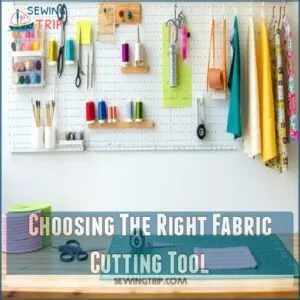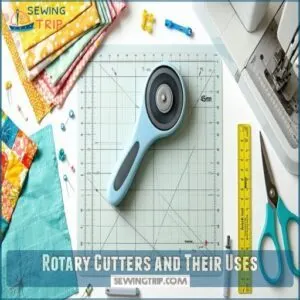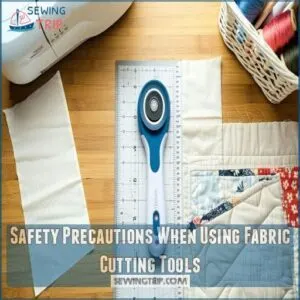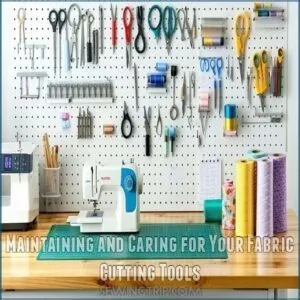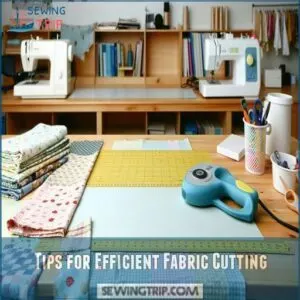This site is supported by our readers. We may earn a commission, at no cost to you, if you purchase through links.
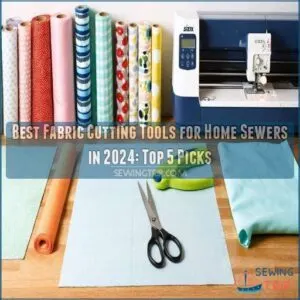
For beginners or crafters, fabric shears are a staple—think of them as your sewing sidekick.
Rotary cutters save time, especially for straight cuts or working with layers, while die-cutting machines like the Sizzix Big Shot Express bring intricate designs to life.
If you crave versatility and tech, the Cricut Maker 3 or Brother ScanNCut SDX85S offer power and precision.
Prioritize durability and safety—sharp tools are no joke!
Finding the right tool isn’t just practical; it’s the key to turning fabric piles into creative treasures.
Ready to get cutting?
Table Of Contents
Key Takeaways
- Choose a rotary cutter with a self-healing mat for clean, precise cuts and faster project completion.
- Use fabric scissors or shears for detailed cuts, ensuring they’re sharp for better control and accuracy.
- Invest in a versatile cutting machine like the Cricut Maker 3 or Brother ScanNCut SDX85S for intricate designs and multiple material options.
- Prioritize safety by using blade guards, ergonomic handles, and regularly maintaining your cutting tools for peak performance.
Choosing The Right Fabric Cutting Tool
You’ll want to pick the perfect fabric cutting tool to make your sewing projects easier and more fun, so let’s find the right one for you.
Think about what you’ll be making, how often you’ll sew, and what fits your budget.
Types of Fabric Cutters
Need to slice and dice fabric like a pro? You’ve got options! From basic fabric shears and rotary cutters with razor-sharp rotary blades to high-tech laser cutters and die-cutting machines, each fabric cutting tool offers unique perks.
For precise cuts, consider using fabric cutting machines that improve efficiency. Picking the right one depends on your project and budget. Grasping the different types of fabric cutters is the first step to conquering your sewing projects.
Factors to Consider When Selecting a Fabric Cutter
Choosing the best fabric cutting tools starts with considering your space, budget, and sewing needs. Want speed? Electric options excel, but manual ones fit tighter wallets.
Factor in durability—machines should last! Prioritize safety with blade guards.
To find the perfect machine, research fabric cutting machines that match your needs. Match tools to fabric types and skill level for smoother use.
These fabric cutting tips guarantee a happier, hassle-free sewing experience.
Understanding Your Fabric Cutting Needs
So, you’ve thought about your budget and features—now ask yourself, what are you cutting? Slim cotton for quilting, hefty denim for crafting, or delicate silks? Your sewing projects and fabric types shape your needs.
For precision, home sewing tools like rotary cutters are great, while electric fabric cutting tools offer speed. Investing in proper Fabric Cutting tools can greatly enhance your sewing experience.
Match your crafting goals to the right gear!
What Are The Best Fabric Cutting Tools
In the context of fabric cutting tools, having the right ones can make or break your project. Whether you’re quilting, sewing, or crafting, precision and ease matter.
Here are the must-haves:
- Best Fabric Shears: A sharp pair of fabric scissors is perfect for detailed cuts—invest in a high-quality pair for longevity.
- Rotary Cutter for Fabric: Ideal for straight cuts, quilting tools, or cutting multiple layers, the 45mm rotary cutter is a favorite.
- Cutting Mats: Protect your surfaces and get cleaner edges with a self-healing mat—trust me, it’s a sewing essential.
- Marking Tools: From chalk to washable pens, accurate markings improve cutting accuracy without stress.
For ideal results, consider investing in the best fabric cutting machine that suits your needs.
With these home sewing tools, you’ll tackle projects like a pro while keeping blade safety in mind!
Top 5 Fabric Cutting Machines for Home Sewers
In the context of fabric cutting machines, choosing the right one can feel like picking the perfect tool out of a crowded toolbox—exciting but a little overwhelming.
Don’t worry; we’ve rounded up the top five options to make your sewing projects faster, cleaner, and much more fun!
1. Sizzix Big Shot Express Electric Die Cutter
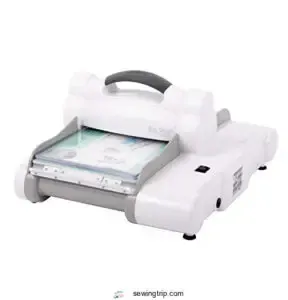
The Sizzix Big Shot Express offers push-button ease for cutting and embossing a wide variety of materials.
Perfect for card making, scrapbooking, and home décor projects, this electric die cutter handles Sizzix dies up to 6" wide.
While some users have reported past reliability issues, the current version aims for smoother performance, a bonus is that it’s portable and quieter than other die-cutting machines, making crafting more enjoyable.
Best For: Beginners and crafters looking for an easy-to-use, electric die-cutting machine for smaller projects up to 6" wide.
- Electric operation eliminates the need for manual cranking.
- Quiet and portable design allows for enjoyable crafting sessions.
- Compatible with a wide range of Sizzix dies and embossing folders.
- May require multiple passes for thicker materials or intricate cuts.
- Button must be held down throughout the cutting process.
- Reports of past reliability issues, though improvements have been made in the current version.
2. AccuQuilt Beginner Fabric Cutting System
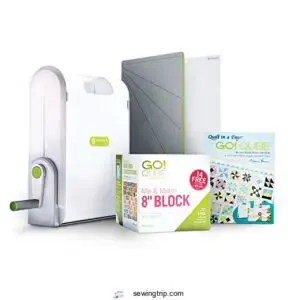
Transforming fabric cutting from a chore into a breeze, the AccuQuilt Beginner Fabric Cutting System offers speed and accuracy. This all-in-one system slices through various materials, including cotton, wool, leather, and even silk. Forget fumbling with scissors—it’s 90% faster, saving you valuable time and energy.
With over 70 free patterns, an instructional CD, and compatibility with 200 dies, the AccuQuilt system empowers you to tackle projects of all sizes. Its safe, portable design minimizes strain, although storage space is a consideration.
When choosing a machine, researching the best fabric cutting machine options is crucial for efficient fabric preparation.
Best For: Beginners looking for a fast, accurate, and user-friendly fabric cutting solution to simplify quilting and sewing projects.
- Cuts 90% faster than scissors or rotary cutters, saving time and effort.
- Includes over 70 free patterns and an instructional CD for easy project inspiration.
- Compatible with over 200 piecing dies, enabling a wide range of creative options.
- Dies can be expensive, adding to the overall cost.
- Requires dedicated space for operation and storage.
- Sharp dies need careful handling to avoid injury.
3. Cricut Maker 3 Smart Cutting Machine
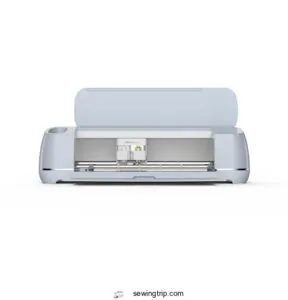
Ready to level up your crafting game? The Cricut Maker 3 Smart Cutting Machine is a powerhouse that cuts over 300 materials, from delicate fabric to sturdy balsa wood.
It’s Bluetooth-enabled and works with the easy-to-learn Design Space app, making customization a breeze.
With options to engrave, emboss, and more using 13 compatible tools, this machine handles intricate designs like a pro, and is perfect for creating personalized DIY wonders, such as personalized mugs and t-shirts.
While it’s a bit heavy and demands proprietary supplies, it’s perfect for creating these items, making it a great tool despite some limitations.
Best For: Crafters and DIY enthusiasts looking for a versatile cutting machine that handles a wide range of materials and projects with precision.
- Cuts over 300 materials, including fabric, vinyl, wood, and cardstock.
- Bluetooth-enabled with access to an easy-to-learn Design Space app for customization.
- Compatible with 13 different tools for engraving, embossing, and more.
- Requires expensive proprietary supplies for some projects.
- Software can be difficult to navigate for beginners.
- Heavy and not easily portable.
4. Brother ScanNCut SDX85S Cutting Machine
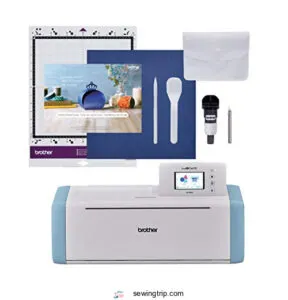
When you want to craft like a pro, the Brother ScanNCut SDX85S is your secret weapon.
With its built-in scanner, 251 designs, and auto blade sensor, this machine combines creativity and convenience.
It smoothly cuts materials up to 3mm thick—think vinyl, fabric, even chipboard.
The user-friendly touchscreen lets you easily customize designs, though the software setup might test your patience.
Accessories can be pricey, but its quiet operation and versatility make it a favorite for ambitious projects.
It’s a creative powerhouse in disguise!
Best For: Crafters who want a versatile and precise cutting machine with scanning capabilities for custom and built-in designs.
- Built-in scanner for personalized designs and 251 pre-loaded options.
- Cuts up to 3mm thick materials like vinyl, fabric, and chipboard with auto blade sensor technology.
- Quiet operation compared to other cutting machines.
- Accessories and replacement parts are expensive and hard to find.
- Software setup can be tricky for some users.
- Limited to 120 volts, making it suitable only for use in the US.
5. Silhouette Cameo 4 Cutting Machine
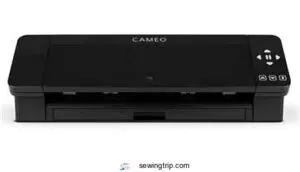
The Silhouette Cameo 4 is a beast of a cutting machine, perfect for tackling tough materials like leather, wood, and even metal.
With 20 times the force of earlier models and blazing cutting speeds, it’s built for ambitious crafters.
Its AutoBlade adjusts automatically, saving you time, while the dual carriage system handles intricate designs like a pro.
The built-in vinyl roll feeder and crosscutter make vinyl projects smoother.
It’s powerful, budget-friendly, and versatile, though mastering the software might take patience.
Best For: Serious crafters and small business owners looking for a powerful, versatile cutting machine for intricate designs and tough materials.
- Handles tough materials like leather, wood, and metal with 20x cutting force.
- AutoBlade and dual carriage system streamline intricate and complex projects.
- Built-in roll feeder and crosscutter simplify vinyl cutting and save time.
- Software has a learning curve, especially for beginners.
- Can be noisy during operation, which may bother some users.
- Not compatible with older Silhouette tools, limiting accessory options.
Essential Fabric Cutting Accessories and Tips
Having the right fabric cutting accessories can make your sewing projects smoother and way less stressful.
From rotary cutters to maintenance tips, let’s make sure you’re armed with the essentials to save time and frustration.
Rotary Cutters and Their Uses
A rotary cutter for fabric is a game-changer for precise cuts. Pair it with a self-healing mat and quilting tools for the best results.
Consider these tips:
- Use sharp rotary cutter blades for smooth slicing.
- Opt for 45mm sizes for versatility.
- Keep Rotary Blade Care in check with regular replacements.
- Explore complete rotary cutter sets.
- Choose ergonomic handles for comfort.
For beginners, following fabric cutting tips is essential to achieve professional-looking results.
Safety Precautions When Using Fabric Cutting Tools
Cutting fabric’s fun—until it’s not! Always check rotary cutter safety: use blade guards, ergonomic handles, and follow proper fabric cutting techniques.
Keep rotary blades sharp and away from kids for solid child protection. Accidentally nicked yourself? Know emergency procedures.
Quilting tips to avoid fabric fraying? Go slow and steady. Safety features save stitches—literally and figuratively!
Maintaining and Caring for Your Fabric Cutting Tools
Keep your tools in top shape by sharpening blades and replacing dull rotary cutter blades regularly.
Clean machines often to prevent lint buildup—compact sewing tools love fresh starts.
Use proper storage solutions to protect fabric cutting supplies, and stick to a maintenance schedule.
Practice rotary cutter safety to keep cutting seamless and frustration-free, and reliable tools mean smoother projects!
Tips for Efficient Fabric Cutting
When you’re the boss of your sewing projects, a little planning goes a long way.
- Pre-wash your fabric for smoother cuts.
- Use a fabric cutting mat and quilting ruler for precision methods.
- Try a rotary cutter for fabric for clean curves or straight edges.
- Sharpen your best fabric shears and rotary cutter blades often for seamless results.
Investing in quality Rotary Cutter Tools can greatly enhance your fabric cutting experience.
Frequently Asked Questions (FAQs)
What is the best tool for cutting fabric?
Did you know a rotary cutter slices fabric cleaner than scissors 90% of the time? Pair it with a self-healing mat for precision.
For bigger projects, try the Cricut Maker—versatile and easy to use!
What is the appropriate cutting tool for cutting fabrics?
You’ll love a rotary cutter for precise fabric cuts—it’s affordable, versatile, and easy to use.
For detailed projects, smaller blades shine, while larger ones tackle thick layers.
Electric cutters? Perfect for speed and convenience!
What is the most efficient way to cut fabric?
Cutting fabric efficiently is like slicing butter with a hot knife—use a rotary cutter with a sharp blade, a clear ruler for precision, and a sturdy cutting mat to save time and guarantee accuracy.
This sentence has been reorganized to be on two lines for better readability, with the entire original sentence on the first line and an empty second line for visual separation.
What is a sewers tool for cutting?
A sewer’s go-to tool for cutting is a rotary cutter paired with a self-healing mat.
It slices fabric smoothly, saves time, and beats scissors for precision—perfect for quilting or tackling straight lines effortlessly.
What is the best machine to cut fabric?
Why wrestle with dull scissors when the Cricut Maker 3 can slice through fabric like butter?
Its rotary blade handles detailed cuts effortlessly, while its versatility fits quilting, sewing, and crafting—all with precision and ease.
What cutting tools do you need to cut fabric?
You’ll want sharp fabric scissors for detailed cuts, a rotary cutter for smooth, straight edges, and a self-healing cutting mat to protect surfaces.
Add a ruler or template for precision, and you’re set!
What is the best rotary cutter for fabric cutting?
Cutting fabric feels like slicing butter with the OLFA 45mm Rotary Cutter.
It’s durable, sharp, and ergonomic, perfect for precision and comfort.
Pair it with sharp Endurance blades to slice through projects with ease.
What cutting tools are used in sewing?
Sewing relies on fabric scissors for precision, rotary cutters for speed, and pinking shears to prevent fraying.
Add thread snips for small trims and a seam ripper for those “oops” moments.
Keep them sharp!
How to choose a fabric cutting machine?
Feeling overwhelmed by options? Start with your needs: manual or electronic, speed or precision, budget or features.
Look for ease of use, cutting size, and durability. Don’t forget ongoing costs like blades!
What is the best manual fabric cutting machine?
Ultimate Fabric Cutter is your best bet.
It’s manual, super precise, and perfect for quilting projects.
Plus, it’s compatible with AccuQuilt dies, making your cutting process faster and frustration-free.
Conclusion
Cutting fabric is like setting the foundation for a masterpiece—using the best fabric cutting tools for home sewers makes all the difference.
Whether it’s the precision of the Cricut Maker 3 or the ease of a staple like the Sizzix Big Shot Express, the right tool brings your creative vision to life.
Focus on your needs, stay safe, and maintain your tools for lasting performance. With a bit of practice, you’ll cut like a pro in no time!

